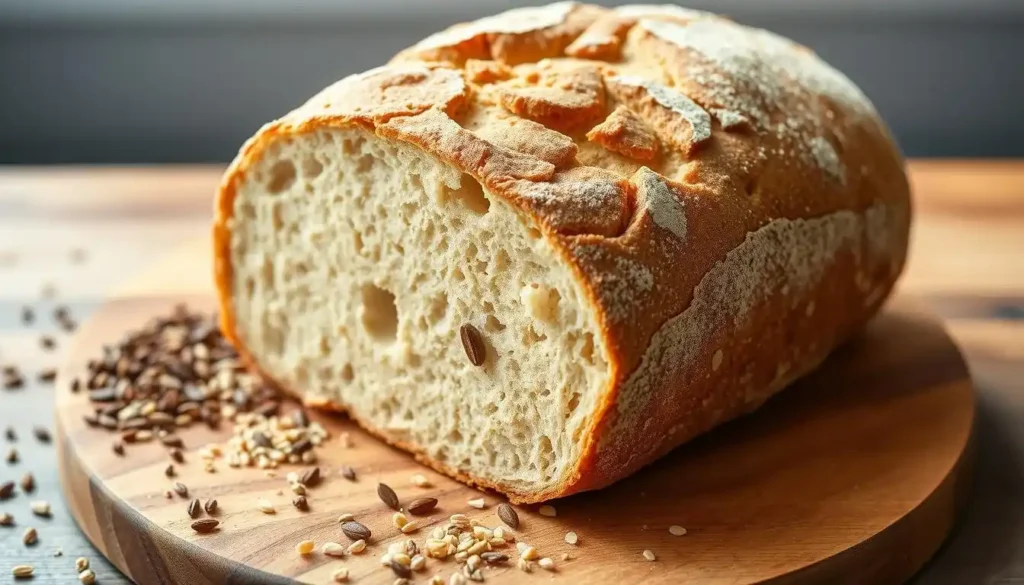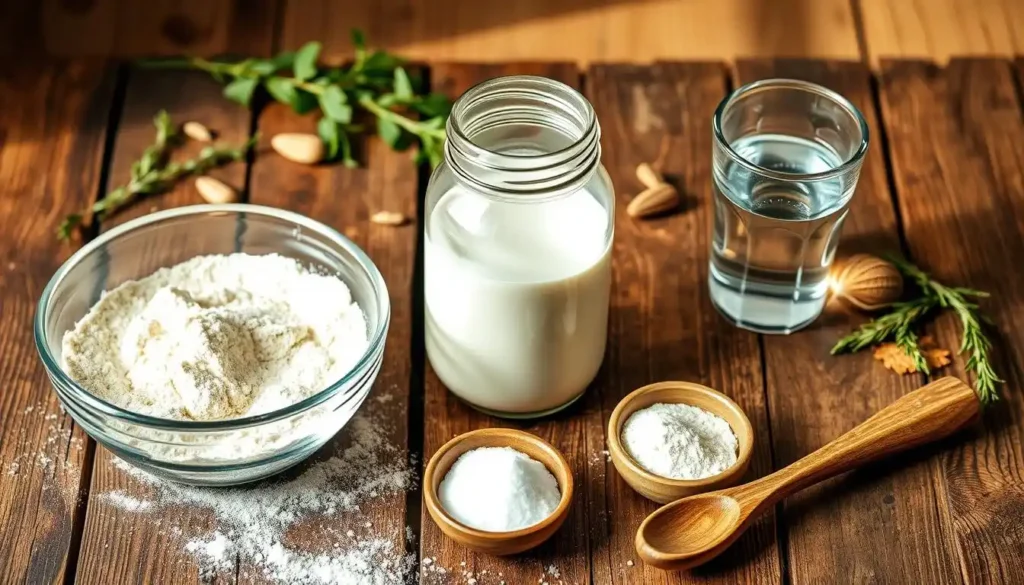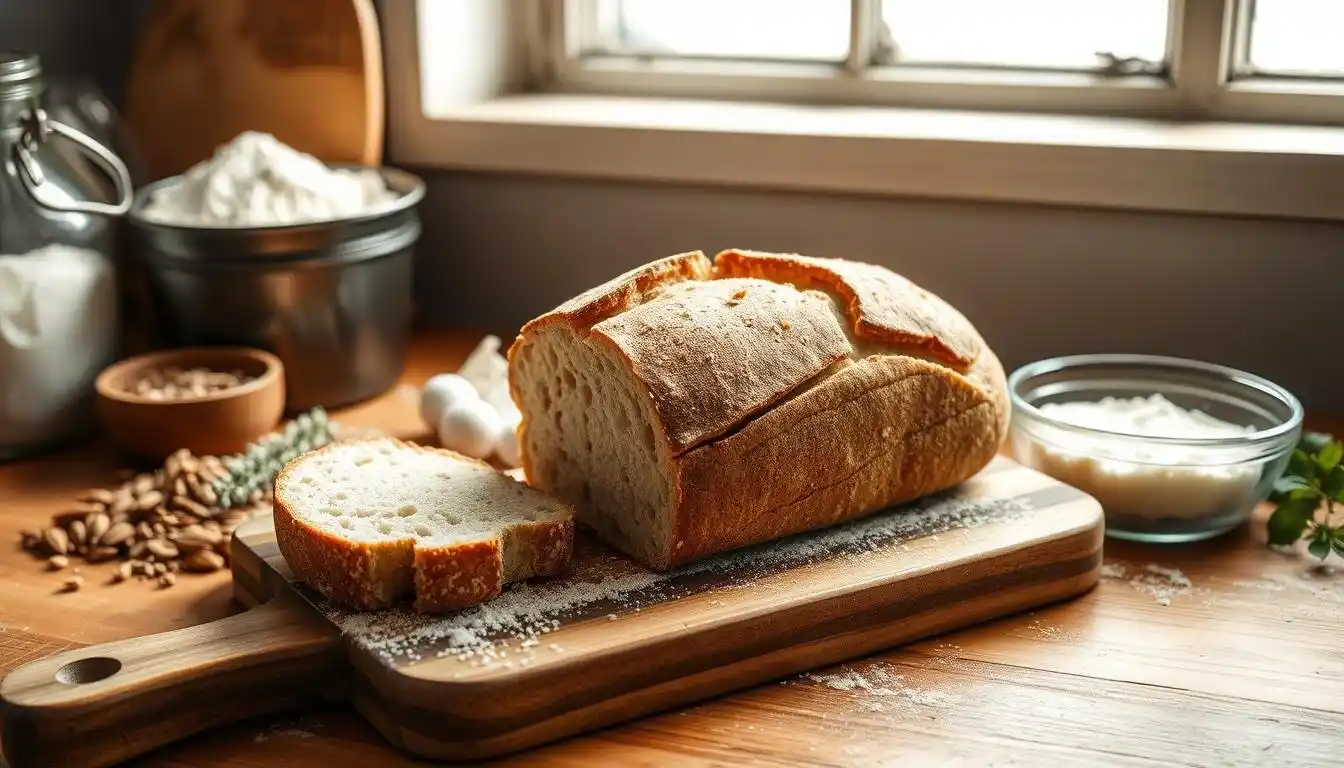I remember the day my world changed. A doctor’s visit told me I couldn’t eat gluten-filled bread anymore. The thought of losing my favorite crusty bread was hard to accept.
But then, I found hope. I could make gluten-free sourdough bread. It could bring back the joy of baking I once knew.
Now, I’m excited to share how to make gluten-free sourdough bread. This guide is for anyone who wants a healthier, tastier bread option. You’ll learn to make gluten-free sourdough bread like a pro in your kitchen.
This post may contain affiliate links. Read my privacy policy. If you
Table of Contents
Understanding Gluten-Free Sourdough Basics
Sourdough bread is special and often not well understood. It doesn’t use commercial yeast like regular bread. Instead, it uses a starter made from flour and water.
This starter fermentation gives sourdough its tangy taste. It also makes it different from bread that has gluten.
What Makes Sourdough Different from Regular Bread
The main difference is how it rises. Regular bread uses quick yeast, but sourdough uses a slow fermentation. This is thanks to wild yeast and bacteria in the starter.
This slow rise makes the dough taste complex and feel chewy. It’s a texture and taste that regular bread can’t match.
Benefits of Gluten-Free Fermentation
- Improved digestibility: The fermentation breaks down gluten. This makes gluten-free sourdough easier to digest.
- Enhanced nutrient availability: The fermentation makes vitamins, minerals, and antioxidants more available in the bread.
- Reduced antinutrients: The process can lower antinutrients like phytic acid. These can block nutrient absorption.
Key Components of Gluten-Free Sourdough
Making gluten-free sourdough needs the right mix of ingredients and techniques. The main parts are:
- Gluten-free flours: A mix of flours like rice, millet, or buckwheat gives the bread its structure and texture.
- Gluten-free starter: A starter made from gluten-free flour and water is fermented. This develops the sourdough flavor.
- Hydration levels: The dough needs the right amount of moisture. This ensures it’s airy and has an open crumb.
- Fermentation time: The dough must ferment for the right amount of time. This brings out the flavors and health benefits of gluten-free sourdough.
Learning about gluten-free sourdough opens up a world of tasty and healthy baking.

Essential Ingredients for Perfect Gluten-Free Sourdough Bread
Making a delicious gluten-free sourdough bread needs the right mix of ingredients. Each part plays a key role in getting the right texture and taste. Let’s consider what you need to make a tasty gluten-free sourdough loaf.
The heart of gluten-free sourdough is the flour. Unlike traditional sourdough, which uses wheat flour, gluten-free bakers use other grains and starches. Common choices include rice flour, tapioca flour, sorghum flour, and potato starch. They help the bread rise and have a similar texture to gluten-containing breads.
Xanthan gum is also key. It helps keep the bread’s crumb together and stops it from falling apart. Psyllium husk or ground chia seeds can also help with the bread’s structure and texture.
| Ingredient | Purpose |
|---|---|
| Gluten-free flours (rice, tapioca, sorghum, potato starch) | Provide structure and rise |
| Xanthan gum | Binding agent to hold the crumb together |
| Psyllium husk or ground chia seeds | Additional binding and texture-enhancing ingredients |
| Water | Hydrate the dough and enable fermentation |
| Salt | Enhance flavor and control fermentation |
| Honey or maple syrup (optional) | Add a touch of sweetness and promote browning |
Water is needed to hydrate the dough and start fermentation. A bit of salt is also essential for flavor and controlling fermentation. Some bakers add honey or maple syrup for sweetness and a golden crust.
Knowing the role of each gluten-free sourdough bread ingredient is key. It helps you make a loaf that looks great and tastes amazing.

Creating Your Gluten-Free Sourdough Starter
Making a gluten-free sourdough starter is the first step to baking tasty gluten-free bread. Knowing how gluten-free fermentation works is important, especially if you’re new to sourdough. This knowledge is crucial for success.
Choosing the Right Flour Blend
Choosing the right flour blend is key for a healthy gluten-free sourdough starter. Use a mix of gluten-free flour like brown rice, sorghum, and tapioca starch. This blend helps your gluten-free sourdough bread starter grow well.
Feeding Schedule and Maintenance
- Feed your starter regularly, once or twice a day, to keep it alive and healthy.
- Use a 1:1:1 starter, flour, and water ratio for the right balance.
- Keep your starter in a warm, draft-free spot for the best fermentation.
Signs of a Healthy Starter
A healthy gluten-free sourdough starter shows several signs. Look for:
- Consistent bubbling and growth after feeding.
- A nice, tangy smell.
- A smooth, thick texture.
- It should double or triple in size 8-12 hours after feeding.
By understanding how to care for a gluten-free sourdough starter, you’re ready to bake delicious gluten-free sourdough bread.
Required Equipment and Tools
Baking gluten-free sourdough bread at home needs some key tools and equipment. The right gear is crucial, from the mixing bowl to the scoring knife. Let’s examine the must-have items for perfecting those gluten-free sourdough bread loaves.
- Durable mixing bowls: Choose sturdy, non-reactive bowls for handling the dough and fermentation.
- Digital kitchen scale: Accurate measurements are key for gluten-free sourdough, so a reliable scale is essential.
- Proofing baskets or bannetons: These baskets help shape and support the dough during the final proofing stage.
- Dutch oven or baking stone: A heavy-duty Dutch oven or baking stone creates the perfect crust and crumb texture.
- Dough scraper: This tool makes handling the sticky gluten-free dough easier and helps shape your loaves.
- Lame or scoring knife: A sharp scoring knife is vital for creating beautiful slashes on your bread.
- Thermometer: Monitoring the temperature of your dough, oven, and starter is crucial for consistent results.
With these gluten-free sourdough bread equipment essentials, you’re on your way to baking amazing loaves at home. Quality tools are key to a successful gluten-free sourdough journey.
| Equipment | Purpose |
|---|---|
| Mixing Bowls | Sturdy, non-reactive bowls for mixing and fermenting the dough |
| Digital Kitchen Scale | Accurate measurements for precise ingredient ratios |
| Proofing Baskets | Specialized containers for shaping and supporting the dough during final proofing |
| Dutch Oven or Baking Stone | Enables the creation of a crisp, evenly baked crust |
| Dough Scraper | Assists in handling the sticky gluten-free dough and shaping the loaves |
| Lame or Scoring Knife | Allows for the creation of beautiful scored patterns on the bread surface |
| Thermometer | Ensures accurate temperature control for the dough, oven, and starter |
Investing in the right gluten-free sourdough bread equipment makes baking more efficient and fun. With the right tools, you’ll be ready to bake delicious, artisan-quality loaves at home.
Step-by-Step Gluten-Free Sourdough Bread Recipe
Making gluten-free sourdough bread at home is simpler than you might think. Follow this guide to make your own tasty and healthy loaf of gluten-free sourdough bread.
Mixing the Dough
Mix your gluten-free sourdough starter with flour blend, water, and extra ingredients like salt or herbs. Make sure to mix everything well. The dough should feel slightly sticky and soft.
Fermentation Process
Let the dough ferment overnight or overnight in a warm, draft-free spot. This step is key for the bread’s unique taste and texture. Watch the dough as it rises and changes.
Shaping Techniques
After fermentation, shape the dough into a nice loaf. Place it on a floured surface and shape it into a round or oblong form. Be gentle to keep the dough from losing its air.
You’re baking delicious gluten-free sourdough bread at home with these easy steps. Enjoy the journey and the tasty outcome!
Best Flour Combinations for Superior Results
Baking gluten-free sourdough bread can be a challenge. The right flour mix is crucial for the perfect texture and taste. Let’s look at some top flour combinations for great gluten-free sourdough bread.
Versatile Blend for Consistent Performance
A reliable mix for gluten-free sourdough includes gluten-free sourdough flour blend, brown rice flour, and tapioca flour. This mix balances structure, moisture, and rise. It’s a go-to for consistent results.
Nutritional Powerhouse
Try gluten-free sourdough flour blend, millet flour, and quinoa flour for a loaf packed with nutrients. Millet and quinoa boost protein, fiber, and vitamins. The gluten-free sourdough flour blend ensures a great texture.
| Flour Blend | Benefits |
|---|---|
| Gluten-free sourdough flour blend, brown rice flour, tapioca flour | Consistent performance, balanced texture, and reliable rise |
| Gluten-free sourdough flour blend, millet flour, quinoa flour | Nutrient-dense, high in protein and fiber, with a desirable texture |
Experimenting is key to finding the best flour mix for your gluten-free sourdough. With a bit of trial and error, you’ll soon make amazing loaves every time.
Mastering the Perfect Crust and Crumb
Getting the perfect crust and crumb in your gluten-free sourdough bread is key. It makes your bread look and feel great. By knowing what to focus on, you can make loaves that rival those from the bakery.
Temperature Control
Controlling the temperature is crucial for a crispy crust and a light crumb. Ensure your oven is hot, between 450°F and 500°F, before baking your gluten-free sourdough bread. Keep the stove at this high heat to help the dough expand and form a strong crust.
Steam and Baking Methods
Adding steam to your baking can make a big difference. Try using a cast-iron pan or metal dish filled with hot water on the oven’s bottom rack. This creates steam that helps the dough rise and gives it a shiny crust. Also, baking stone or steel can help distribute heat evenly, making the bottom crust crisp.
| Technique | Benefit |
|---|---|
| High Temperature Baking | Promotes rapid expansion and crust formation |
| Steam Injection | Enhances rise, crust texture, and crumb structure |
| Baking Stone or Steel | Ensures even heat distribution for a crisp bottom crust |
Mastering temperature control and using steam and special baking methods will help you make gluten-free sourdough bread. Your bread will have a crispy crust and a light, airy crumb. It will impress everyone you share it with.
Troubleshooting Common Issues
Baking gluten-free sourdough bread can be rewarding but also challenging. You might face some common problems on your gluten-free sourdough journey. But don’t worry; with the right troubleshooting techniques, you can overcome these obstacles and get delicious results.
Dense Texture and Lack of Rise
One common issue is a dense, heavy texture that does not rise enough. This can happen due to an underdeveloped starter, wrong hydration levels, or proofing times. To fix this, make sure your starter is active and strong. Adjust the water-to-flour ratio and watch the fermentation and proofing stages closely.
Gummy or Undercooked Crumb
A gummy, undercooked crumb can be a problem. It’s often because the crumb is not baking long enough or at the right temperature. Preheat your oven well and use an oven thermometer for consistent temperatures. Also, try baking longer or adjusting the oven rack to get a perfectly cooked crumb.
| Common Gluten-Free Sourdough Issues | Potential Causes | Solutions |
|---|---|---|
| Dense texture and lack of rise | – Underdeveloped or imbalanced starter – Improper hydration levels – Inaccurate proofing times | – Ensure a robust, active starter – Adjust water-to-flour ratio – Monitor fermentation and proofing stages |
| Gummy or undercooked crumb | – Insufficient baking time or temperature | – Preheat oven thoroughly – Use a reliable oven thermometer – Extend baking time or adjust oven rack position |
Remember, solving gluten-free sourdough bread issues takes time and effort. But with persistence and a willingness to learn, you can beat these common gluten-free sourdough bread problems and get the perfect loaf. Enjoy the journey, try new things, and savor the delicious results of your hard work.
Storage Tips and Shelf Life
Keeping your gluten-free sourdough bread fresh is key to enjoying it for longer. The right storage and containers can help. This way, your homemade bread stays delicious for days.
Freezing Methods
Freezing is a great way to keep your bread fresh longer. Here’s how to freeze it right:
- Let the bread cool down completely before freezing.
- Wrap it tightly in plastic wrap or foil to avoid freezer burn.
- Put the wrapped bread in a resealable bag or airtight container.
- Freeze it for up to 3 months for the best taste.
Proper Storage Containers
The right container is crucial for your bread’s longevity. Here are some good options:
| Container | Pros | Cons |
|---|---|---|
| Paper bag | Allows the bread to breathe and prevents moisture buildup | Offers less protection against drying out |
| Airtight container | Keeps the bread fresh for longer by locking in moisture | Can cause the crust to soften over time |
| Bread box | Provides a balance of airflow and moisture retention | Takes up more counter space |
Choose any container you like, but store your bread at room temperature. Keep it away from heat or sunlight. With proper storage, your bread can last for days or weeks.
Flavor Variations and Add-ins
Adding different flavors to your gluten-free sourdough bread can make it even better. You can use herbs and spices, nuts, or dried fruits. These options let you customize your loaf in many ways.
Adding fresh or dried herbs like rosemary, thyme, or basil can give your bread a Mediterranean taste. Try mixing different herbs to find your favorite flavor.
Add chopped olives, sun-dried tomatoes, or crumbled feta cheese for a savory twist. These ingredients can make your bread more interesting and perfect for various meals.
For a sweet touch, mix in chopped nuts or dried fruits. The combination of sourdough’s chewiness and the add-ins’ texture can make your bread unforgettable.
| Flavor Addition | Suggested Quantity (per loaf) |
|---|---|
| Fresh Herbs (chopped) | 2-3 tablespoons |
| Dried Herbs | 1-2 teaspoons |
| Olives (chopped) | 1/2 cup |
| Sun-Dried Tomatoes (chopped) | 1/4 cup |
| Crumbled Feta Cheese | 1/3 cup |
| Chopped Nuts | 1/2 cup |
| Dried Fruit | 1/3 cup |
Getting the right balance is key when adding flavors. Make sure the extra ingredients enhance your bread’s taste without taking over. Feel free to try different mixes and adjust amounts to your liking.
“The beauty of gluten-free sourdough bread is that it serves as a blank canvas, allowing you to create truly unique and delicious loaves that reflect your culinary creativity.”
Tips for Achieving the Perfect Rise
Learning to make gluten-free sourdough bread rise well is a big step in baking. Knowing what affects the rise helps you make loaves that are light and full of flavor. Let’s explore the secrets to getting that perfect rise.
Understanding Hydration Levels
Hydration is key in gluten-free sourdough baking. The right mix of water and flour is crucial. Aim for 70-85% hydration to get a dough that rises well.
Proofing Techniques
- Proof with patience: Let your dough proof for 4-8 hours, depending on the temperature. Rushing can make it dense.
- Control the environment: Keep it warm and humid to help it rise. Avoid dry or drafty places.
- Use the right tools: Get a proofing basket or bowl to support your dough as it rises.
Understanding hydration and proofing is key to a great rise. Experiment and adjust until you find what works best for you.
Health Benefits of Gluten-Free Sourdough
Gluten-free sourdough bread is a great choice for health lovers. It’s easy to digest and full of nutrients. This bread can make you feel better overall.
One big plus is how easy it is to digest. The fermentation process breaks down hard-to-digest parts. This is good for people with gluten issues or wanting softer bread.
The fermentation also makes nutrients easier to get from the bread. The good bacteria help your body use vitamins and minerals better. This means you get more nutritional value with each bite.
Gluten-free sourdough is also good for your gut. The bacteria from fermentation help keep your gut healthy. A healthy gut is key for digestion, immune function, and mood.
| Health Benefit | Explanation |
|---|---|
| Improved Digestibility | The fermentation process breaks down complex carbohydrates and gluten, making the bread easier to digest. |
| Enhanced Nutrient Absorption | The fermentation process increases the bioavailability of essential nutrients, allowing your body to absorb them more efficiently. |
| Gut Health Benefits | The probiotic properties of gluten-free sourdough can help maintain a healthy gut microbiome, supporting overall well-being. |
Adding gluten-free sourdough to your diet is a tasty way to improve your health. It’s a delicious and nutritious choice. Try baking some today!
Conclusion
Congratulations on finishing this guide to baking gluten-free sourdough bread. You’ve learned about sourdough fermentation and how to make the perfect loaf. This guide covered the basics of gluten-free sourdough.
You now know how to make your own sourdough starter and try different flour blends. Remember, success comes from patience, attention to detail, and being ready to solve problems.
This guide is for both experienced and new gluten-free bakers. It gives you the tools and knowledge to make amazing gluten-free sourdough bread home. Enjoy the fermentation process, try new flavors, and taste your homemade gluten-free sourdough. Happy baking!
FAQ
What makes sourdough bread different from regular bread?
Sourdough bread uses a live culture called a sourdough starter. Regular bread uses commercial yeast. This makes sourdough tangy and chewy.
What are the benefits of gluten-free fermentation?
Gluten-free fermentation makes bread easier to digest, boosts nutrient absorption, and may improve gut health. The process also enhances the texture and flavor of gluten-free sourdough.
What are the key components of gluten-free sourdough?
Gluten-free sourdough needs a flour blend, an active starter, and xanthan gum for structure. These ingredients replace gluten.
How do I choose the right flour blend for my gluten-free sourdough starter?
Pick a flour blend that’s nutrient-rich and fermentable. Brown rice, millet, sorghum, or tapioca are good options.
How do I maintain a healthy gluten-free sourdough starter?
Feed your starter every 12-24 hours. Watch for signs of fermentation, like bubbles and a sour smell.
What equipment do I need to bake gluten-free sourdough bread?
You’ll need a bowl, a proofing basket, a Dutch oven, and scoring tools. These help shape the bread.
How can I achieve the perfect crust and crumb in my gluten-free sourdough bread?
Use steam and control the temperature for a crisp crust. Proper shaping and fermentation times are also key.
How can I troubleshoot common issues with gluten-free sourdough bread?
Adjust hydration and fermentation times for a dense texture or gummy crumb. Good kneading and shaping can also help.
How should I store my gluten-free sourdough bread to extend its shelf life?
Store the bread in an airtight container at room temperature. Freezing is also a good option for longer storage.
What creative flavor variations can I add to my gluten-free sourdough bread?
Try adding herbs, spices, nuts, seeds, or dried fruits. You can also use olives or cheese for unique flavors.

